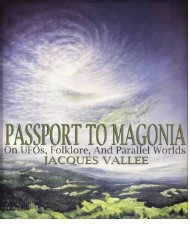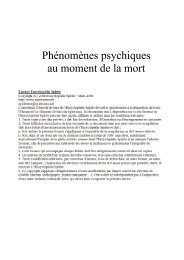extraordinary%20encounters
extraordinary%20encounters
extraordinary%20encounters
You also want an ePaper? Increase the reach of your titles
YUMPU automatically turns print PDFs into web optimized ePapers that Google loves.
2 Abductions by UFOs<br />
In the first case to come to the attention of<br />
ufologists, a Portsmouth, New Hampshire,<br />
couple, Barney and Betty Hill, experienced a<br />
close encounter with a UFO on the night of<br />
September 19–20 while traveling through the<br />
White Mountains. At one point, Barney Hill<br />
stopped the car and stepped out with a pair of<br />
binoculars; through them he saw humanlike<br />
figures inside the craft. One was staring directly<br />
at him. Terrified, the couple fled, all the<br />
while hearing beeping or buzzing sounds.<br />
Once back home, the Hills eventually realized<br />
that at least two hours seemed missing from<br />
their conscious recall. In November Betty had<br />
a series of unusually vivid dreams in which beings<br />
forced her and her husband into a UFO.<br />
She and Barney were separated, and Betty underwent<br />
a medical examination with a grayskinned<br />
humanoid, whom she understood to<br />
be the leader. In January they sought out<br />
Boston psychiatrist Benjamin Simon in an effort<br />
to deal with the continuing anxiety they<br />
felt about the incident. Dr. Simon had them<br />
hypnotized, and under hypnosis they separately<br />
recounted an abduction episode. Subsequently,<br />
the story appeared in a Boston newspaper,<br />
and soon afterward journalist John G.<br />
Fuller wrote a best-selling book, The Inter -<br />
rupted Journey, on the case.<br />
A generally similar incident took place in<br />
Ashland, Nebraska, in the early morning<br />
hours of December 3, 1967, when police officer<br />
Herbert Schirmer saw a hovering UFO a<br />
short distance from him. He originally believed<br />
that the sighting had lasted no more<br />
than ten minutes, but when he later realized<br />
that a half hour had passed, he got nervous,<br />
experienced sleeplessness, and heard a buzzing<br />
sound inside his head. Later under hypnosis<br />
Schirmer related an onboard experience with<br />
short, gray-skinned humanoids with catlike<br />
eyes.<br />
During a wave of UFO sightings in October<br />
1973, two Pascagoula, Mississippi, fishermen<br />
claimed that robotlike entities had<br />
floated them into a UFO. The story received<br />
enormous publicity, as did an even more spectacular<br />
incident in November 1975, when a<br />
forestry worker from Snowflake, Arizona, disappeared<br />
after six colleagues saw a beam of<br />
light from a UFO hit him and knock him to<br />
the ground. Travis Walton returned five days<br />
later with fragmentary memories of seeing<br />
two kinds of UFO beings, little gray men and<br />
humanlike (but not human) entities. A few<br />
other stories, now being called “abductions” as<br />
opposed to “kidnappings,” saw print in the<br />
UFO literature but were little noticed elsewhere.<br />
The first book on the larger phenomenon<br />
of UFO abductions (as opposed to a<br />
single case, such as the Hills’s), Jim and Coral<br />
Lorenzen’s book Abducted! was published in<br />
1977.<br />
From the Hill incident on, critics focused<br />
on the use of hypnosis to elicit “re c a l l , ”<br />
pointing out that confabulation under hypnosis<br />
is a well-documented psyc h o l o g i c a l<br />
phenomenon, most dramatically manifesting<br />
in “m e m o r i e s” of past lives. As early as 1977<br />
t h ree California investigators attempted to<br />
demonstrate that volunteers under hypnosis,<br />
i n s t ructed to imagine UFO abductions, told<br />
stories indistinguishable from those re l a t e d<br />
by “re a l” abductees. Other investigators and<br />
o b s e rvers disputed these conclusions, pointing<br />
to methodological and logical pro b l e m s<br />
in the experiment, and subsequent efforts by<br />
other re s e a rchers to replicate it failed. On e<br />
later study indicated that nearly one-third of<br />
abductees consciously re m e m b e red their experiences;<br />
their testimony, folklorist T h o m a s<br />
E. Bu l l a rd concluded, was indistinguishable<br />
f rom corresponding accounts emerging under<br />
hypnotic re g ression. Still, hypnosis and its vagaries<br />
would play a large and continuing ro l e<br />
in the controversy surrounding the abduction<br />
p h e n o m e n o n .<br />
In the late 1970s Budd Hopkins, a New<br />
York City artist and sculptor, working with<br />
psychologist and hypnotist Aphrodite Clamar,<br />
began to investigate the abduction reports.<br />
Through Hopkins’s work new dimensions of<br />
the phenomenon emerged, including not just<br />
little gray humanoids that would come to<br />
dominate abduction reports but also experiences<br />
that began in childhood and recurred





